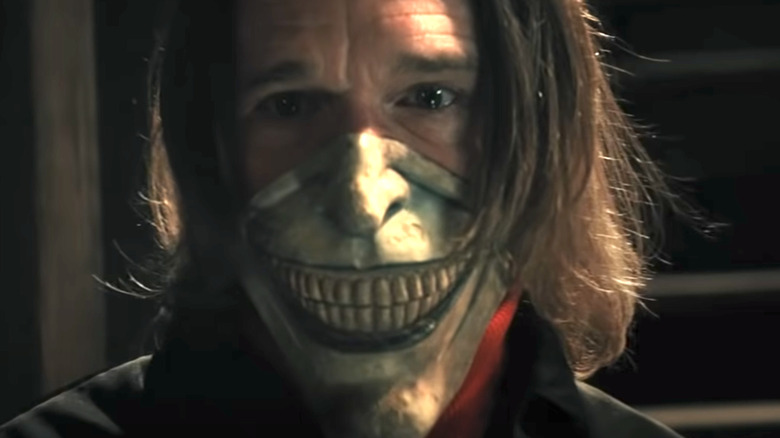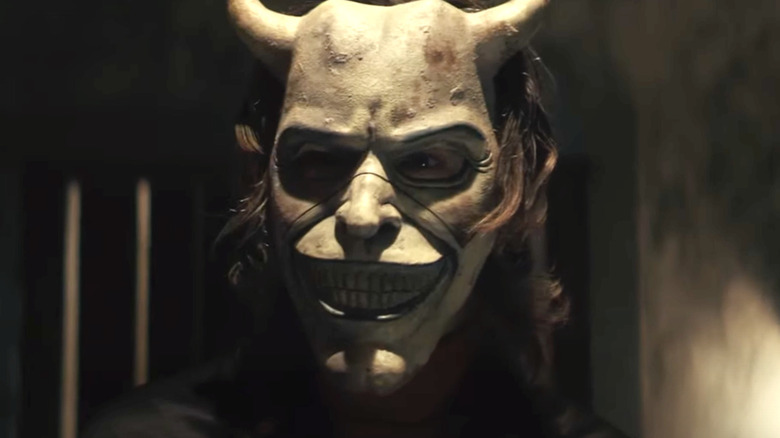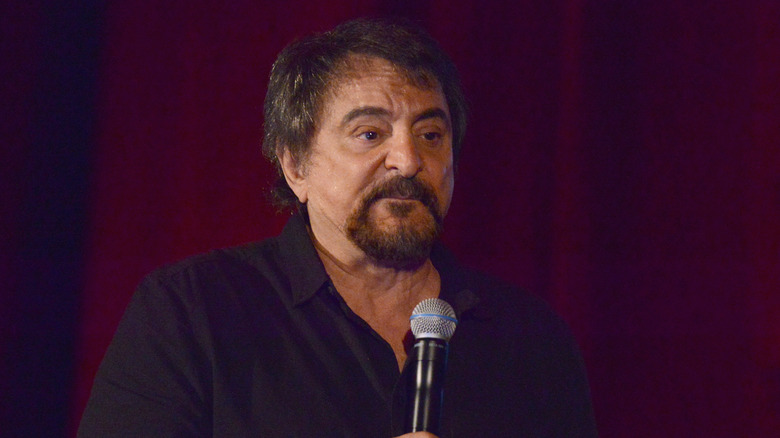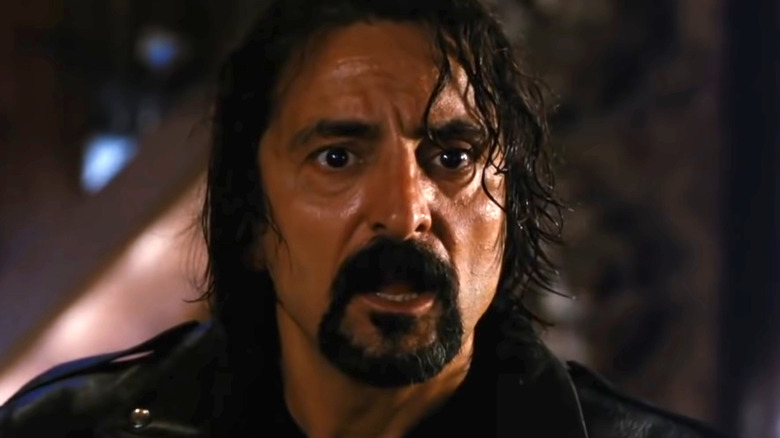The Horror Legend Behind The Black Phone's Unsettling Mask
"The Black Phone," co-written by "Sinister" duo C. Robert Cargill and director Scott Derrickson, is a rare horror movie that has managed to win over both audiences and critics (per Rotten Tomatoes). The film, based on a short story written by Stephen King's son Joe Hill, follows 13-year-old named Finney (Mason Thames) as he is kidnapped by a serial killer known as The Grabber (Ethan Hawke). While locked away in The Grabber's basement, Finney starts receiving phone calls from the shadowy killer's past victims, who band together to help plan his escape.
Even those who haven't seen the film likely recognize the mask of The Grabber, used heavily to sell "The Black Phone" in trailers and on posters. It's quite an unsettling image, with Hawke's blue eyes sitting between horns and an unnaturally wide smile etched into the mask's face. Even more unsettling, the mask appears as one large piece covering Hawke's entire face and, at various points of the movie, is separated into two pieces, one covering just the mouth and another covering just the eyes.
One might expect such memorable visual flair and multi-use design to come from, say, a young up-and-comer raised on the horror genre who might be looking to make their mark within an original story. However, The Grabber's mask design actually comes from a horror legend who has worked on some of the most iconic entries in the horror canon.
Tom Savini designed The Grabber's mask
Tom Savini, responsible for effects work in classics like "Friday the 13th" and "Dawn of the Dead," is the man behind the mask in "The Black Phone." It was revealed in a June 2022 interview with Entertainment Weekly that Scott Derrickson and producer Ryan Turek approached multiple companies for designs because, according to the director, "I just knew, whatever this mask is, it's the thing that they're gonna use to market the movie." They eventually reached out to Savini and business partner Jason Baker, as Derrickson and Turek liked some of the horror-themed COVID-19 masks they made during the pandemic.
"I thought we would get something more unique from someone younger. I was wrong. It's the old legend that still delivers," Derrickson said. "The Black Phone" helmer revealed to EW that the only reference he gave Savini was the 1928 film "The Man Who Laughs," but otherwise left the design up to the horror master. Naturally, he nailed the design in one go. According to Savini, he came up with the design, and then Baker took over the process, including meeting with Ethan Hawke to try out the mask.
Also impressed with the design was Joe Hill, who called it iconic and revealed Savini was attracted to the picture because it didn't break his one rule about children in movies. "Tom told me it was a personal rule with him never to work on a film that exploited children as victims. When he read the script for 'The Black Phone,' he said, 'I'm in,' because it isn't exploitive, because it presents these kids as a tribe, a gang, like 'The Goonies,' and it insists on the richness and value of their lives and gives them back their strength," Hill told Bloody Disgusting.
Savini's career in horror is truly legendary
Scott Derrickson described working with Tom Savini as a dream come true — and for good reason. "For me personally, it was such a blast because I got to create a Universal monster with Tom Savini. If that's not a childhood dream come true, I don't know what is," he told Entertainment Weekly. Savini's list of credits, as seen on IMDb, is almost overwhelming. "Friday the 13th" and "Dawn of the Dead" are among his earliest make-up and special effects credits, respectively. He's also worked on "Texas Chainsaw Massacre 2," William Lustig's "Maniac," "Creepshow," "Creepshow 2," and much more.
Savini's work is so iconic (think the creepily realistic image of an arrow going through Kevin Bacon's neck in "Friday the 13th") because he saw atrocities up close during the Vietnam War. Savini served as a combat photographer, meaning he saw plenty of flesh and gore up close. While speaking to the Pittsburgh Post-Gazette in 2002, he said that a move into special effects was a way to cope with the horrific sights. "This is the reason why my work looks so visceral and authentic. I am the only special effects man to have seen the real thing," Savini said of his unusual but fitting experience in an August 2020 interview with The Independent.
It all sounds like enough to make the guy a horror legend, right? It is, but Savini has given plenty more to the world and the horror genre specifically over the years.
He is also an accomplished actor and director
Tom Savini has not only cultivated a fruitful career behind the camera thanks to his collaborations with horror filmmakers but he's also made his mark on-screen as an actor and director. Robert Rodriguez popped him into his 1996 feature "From Dusk Till Dawn" as the character Sex Machine, a vampire killer who likes to keep his gun in an unusual place. It was a role Jake Busey took over in a TV adaptation, and Savini was brought back as another character for six episodes (via IMDb). He is no stranger to roles in Joe Hill television adaptations, showing up in guest spots on series "Locke & Key" and "NOS4A2." Savini is also an accomplished director, helming episodes of the Shudder adaptation of "Creepshow," as well as the '80s horror anthology show "Tales from the Darkside," per his IMDb profile.
Standing out most on his directing résumé is his 1990 color remake of "Night of the Living Dead," a beloved cult classic among horror fans. According to Savini, producers tried to hold him back as he let loose on his sole feature, one aspect of what he describes as a trying experience. "'Night of the Living Dead' was the most horrible experience of my life. I couldn't wait to go home in the morning. I just didn't want to be there because they kept slapping my hands: 'You're not allowed to do this. You're not allowed to do that.' And my wife divorced me three weeks into shooting, so I was afraid of losing my daughter. There was a lot of turmoil. We're lucky that we got what we did on the screen," he told Daily Dead in October 2014.



